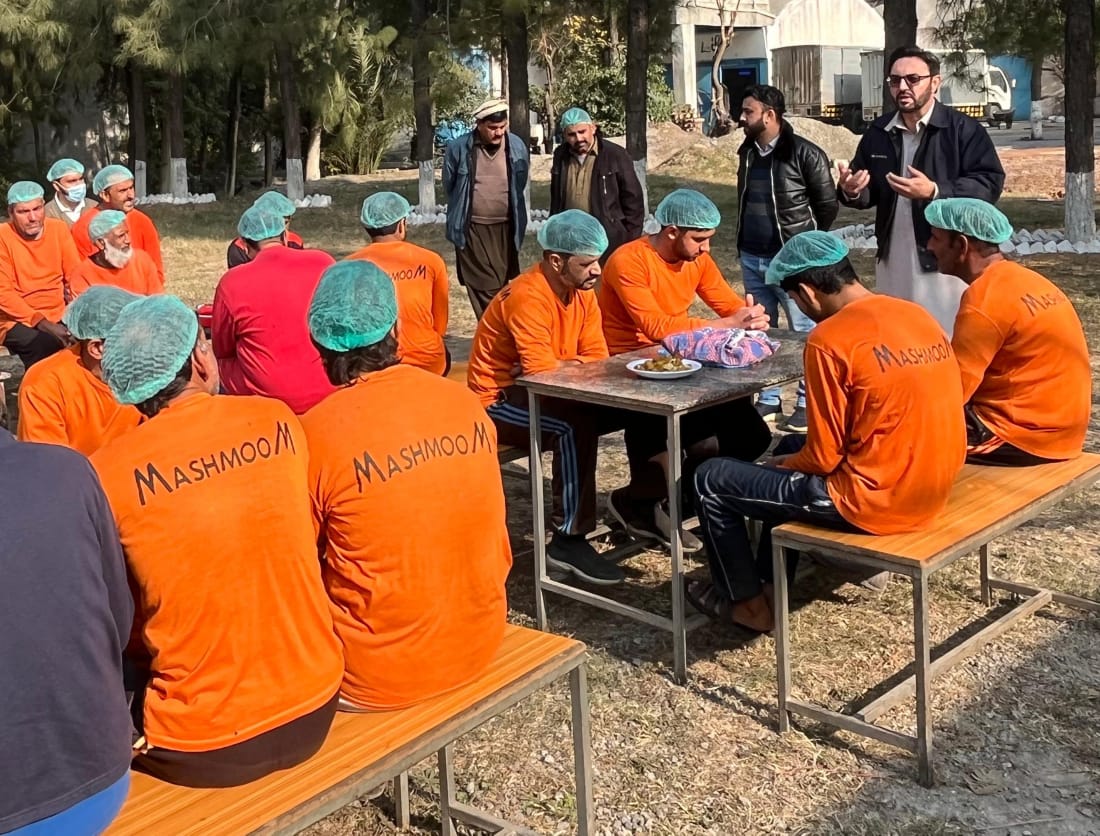Introduction
Every day, thousands of workers across Pakistan’s Hattar Industrial Estate (HIE) clock into jobs that power the country’s manufacturing sector. From ceramics and textiles to printing, chemicals, and food production, these industries depend on a steady, skilled workforce. Yet, behind the manufacturing lines are workers whose nutritional needs are often overlooked. Improving workforce health and productivity can yield broader economic dividends by reducing absenteeism, improving industrial output, and lowering healthcare costs associated with non-communicable diseases (NCDs).

Hattar Industrial Estate is a dynamic hub of 300 medium and large-scale private industries that plays a pivotal role in driving Pakistan’s economy - contributing to industrial growth, job creation, and export revenue. As a centre of manufacturing and production, it supports the livelihoods of 40,000 workers while fuelling regional economic development1,2 .
In December 2024, the Global Alliance for Improved Nutrition (GAIN) conducted a mixed-method study to assess workplace nutrition practices across five industries in HIE. Engaging 60 employers and 400 employees, the study explored nutrition knowledge, practices, and opportunities for implementing GAIN's workforce nutrition programme across its four pillars: healthy food at work, nutrition education, nutrition-focused health checks, and breastfeeding support. These four pillars form the foundation of GAIN’s global workforce nutrition approach, implemented across agricultural and industrial supply chains in multiple countries, aiming to empower workers particularly in low- and middle-income settings with better health and resilience while contributing to business efficiency

What We Learned
‘Nutrition’ is Missing from the Workplace Menu
The study revealed significant gaps in nutritional awareness and support across the five participating industries in Hattar Industrial Estate. While 96% of the factories provided meals to employees - 54% offering one full meal, 32% two meals, and 9% meals plus snacks -, providing nutritious meals was rarely prioritised. Menus were largely driven by taste and affordability, with fried foods, oily stews, and sugary beverages being common offerings. Mixed vegetables, though offered, were typically fried, further diminishing their nutritional value. Most food services lacked formal guidelines aligned with workforce nutrition principles. When researchers introduced employees to the workforce nutrition traffic light model to categorise meals based on their health value, most workers agreed that the meals provided by their organisations would fall into the red or amber zones – highlighting the absence of deliberate, health-focused meal planning.
Employers acknowledged that meal provision was primarily intended to enhance productivity and retain workers - outcomes they recognised as closely tied to employee wellbeing. However, they also discussed persistent illness-related absenteeism, raising concerns about the effectiveness of current practices.
Among employees, awareness of the link between diet and health was limited. Many struggled to define what constituted a nutritious meal and often relied on calorie-dense foods out of habit, cost, or convenience. Even those receiving subsidised meals through their organisation showed challenges in making nutritious choices - 51% of employers offered partially subsidised meals and 10% fully subsidised them. About 34% brought homemade meals - meals that were similarly unbalanced and calorie-dense.
Beyond Meals: A Missed Culture of Care
The study went beyond meals to examine the broader workplace culture of health and care. While basic health checks such as blood pressure and weight monitoring were available in 46% of workplaces, they were often limited in scope and typically not linked to any structured follow-up or nutritional counselling. Only 23% of employees reported receiving tailored follow-up after health checks, despite 92% undergoing checks 2–3 times annually. Although most of these services were offered at no cost to employees, nutrition education was absent. Many workers saw chronic illnesses like diabetes and hypertension as inevitable, unaware of the role that diet, and preventive care could play in managing these risks.
Breastfeeding support was also overlooked. Despite employing female workers, many of the participating industries had no formal policies or facilities to support breastfeeding or infant care. In fact, 84% of organisations reported not adhering to the ILO Convention 183 (which recommends a minimum of 14 weeks of paid maternity leave) or Convention 191 (which extends this to at least 18 weeks) of maternity recommendation. The lack of institutional support highlights a significant gap in creating inclusive, gender-responsive work environments. Implementing flexible schedules, breast feeding facility, and maternity protections can help improve retention and wellbeing of female employees.
An Appetite for Change
Despite the current gaps, both employers and employees demonstrated a strong willingness to engage with workforce nutrition initiatives, particularly, healthy food at work (43%) once they understood the benefits.
More than 72% of employers expressed strong interest in improving the quality of workplace meals after learning about the connection between nutrition, employee health, and productivity. Many were surprised to discover how structured workforce nutrition programmes could reduce absenteeism, boost concentration, and contribute to a more inclusive work environment. While most were unfamiliar with the workforce nutrition programme prior to the study, they were open to practical steps - such as improved menus and introducing basic health services. However, several employers emphasised the need for documented evidence of business benefits and case studies from previous implementations to guide their decision-making.
Employees mirrored this enthusiasm. Many expressed a keen interest in understanding how nutrition influences energy levels, disease prevention, and overall wellbeing. They welcomed support in making healthier food choices and showed strong interest in regular health checks and tailored nutrition education. Notably, there was also growing awareness of the need for gender-inclusive policies, including breastfeeding breaks and designated breastfeeding spaces. Encouragingly, employers acknowledged these needs and showed willingness to support female workers, particularly if provided with feasible, low-cost implementation strategies.
Why this matters: Nutrition, NCDs, and Productivity
The workplace is where many adults spend a third of their waking hours, and often where they consume at least one daily meal. This makes it a critical, yet underutilised, platform for improving diet quality, reducing the risk of diet-related non-communicable diseases, and enhancing business outcomes such as productivity, retention, and employee wellbeing 3.
Globally, poor diets are driving a rapid rise in NCDs. The prevalence of adult diabetes has more than doubled over the past three decades and is projected to affect 1.3 billion people by 2050 if current trends continue 4. In Pakistan, the picture is just as concerning. NCDs are one of Pakistan’s most pressing public health challenges. Conditions such as hypertension and diabetes are on the rise, with national estimates indicating a prevalence of 38.7% and 31.4% respectively5,6. The burden is especially grave in regions like Khyber Pakhtunkhwa - home to Hattar Industrial Estate - where 50% of the population reports at least one NCD related illness 7.
In industrial zones like HIE, where more than 40,000 workers spend the majority of their day and often consume at least one daily meal, the workplace becomes a critical platform for prevention. Integrating workforce nutrition programmes offers a powerful way to tackle NCD risk while also improving productivity, reducing absenteeism, and promoting overall worker wellbeing.
Turning Willingness into Action
The assessment in Hattar Industrial Estate underscores a growing momentum for workforce nutrition reform. Employers increasingly recognise the link between nutrition and productivity and are willing to act, but require structured guidance, practical tools, and a compelling business case to drive uptake. Employees are ready to engage, expressing a strong interest in improving their dietary habits, accessing preventive health services, and working in environments that support inclusivity, particularly for women. Yet, without coordinated, systems-level support, these intentions risk stalling at the level of awareness.

What GAIN Can Do
As a global leader in advancing workforce nutrition, GAIN is well-positioned to catalyse action in HIE through the following strategic entry points:
- Pilot the workforce nutrition programme across selected HIE industries to test feasibility, build implementation capacity, and generate scalable insights for replication across other organisations and industrial estates.
- Convene a multi-stakeholder WFN platform within HIE to enable collaborative planning and coordination between employers, industry associations, public sector actors, and civil society. GAIN will serve as technical lead, providing end-to-end support across design, delivery, and monitoring of interventions.
- Advocate for embedding WFN principles into Responsible Business Conduct (RBC) and Corporate Social Responsibility (CSR) frameworks, positioning workforce nutrition as integral to decent work, occupational health and safety, gender equity, and sustainability commitments. This aligns with GAIN’s ongoing collaboration with the International Labour Organisation (ILO) and broader efforts to advance nutrition-sensitive employment policies.
What Organisations at HIE Can Do
Employers have a critical role to play in institutionalising better nutrition practices at scale. Recommended actions include:
- Improve food environments within the workplace by diversifying meal offerings, minimising reliance on ultra-processed and fried foods, and promoting food safety. Even incremental shifts, such as replacing fried vegetables with steamed options, can yield measurable health benefits.
- Integrate nutrition into occupational health policies, pairing routine screenings (e.g., for hypertension, diabetes) with onsite nutrition counselling and behaviour change communication tailored to workforce profiles.
Strengthen gender-responsive policies by supporting maternal health and breastfeeding through low-cost interventions such as protected breastfeeding breaks, designated rest areas, or community-based childcare models, measures that are essential for improving retention and enabling female workforce participation.

GAIN’s Workforce Nutrition Programme offers industries a proven framework to move from intention to implementation. Grounded in four pillars - healthy food at work, nutrition education, nutrition-focused health checks, and breastfeeding support - the programme equips organisations with the tools, technical support, and real-world models needed to take action. In industrial environments like HIE, these pillars offer a clear roadmap for workplaces to improve nutrition, support breastfeeding mothers, elevate worker wellbeing, and reduce absenteeism, all while strengthening productivity and staff retention. The WFN programme builds on successful implementation across multiple countries like Bangladesh, where GAIN partnered with factory employers and Bangladesh’s ministries of health, and employment, to implement WFN in over 100 garment factories, benefiting more than 100,000 workers.
Results included anaemia reductions by 12 - 32%, a 1.5–2% drop in daily absenteeism, and production gains of up to 70% in some factories, along with higher worker earnings 8. Globally, the Workforce Nutrition Alliance has now reached over 6 million workers, surpassing its 2025 goal 9.
Supporting the case for action, GAIN’s recent evidence review demonstrates that workforce nutrition interventions can deliver tangible business benefits, including reduced sick leave, improved productivity, and enhanced corporate reputation, especially in labour-intensive settings common to industries in many low- and middle-income countries10. By adopting this framework and leveraging learning from other countries, organisations in Hattar Industrial Estate have an opportunity to become pioneers in responsible, health-centred work environments, supporting both worker health and business performance.
References
- Durrani Y, GAIN. Workforce Nutrition in Hattar Industrial Estate (HIE) Pakistan.; 2024.
- Zahid U. Hattar Industrial Estate: A Hub of Economic Activity in Pakistan.
- Quak EJ, Ebata A, Barnett I. A review of the business case for workforce nutrition initiatives. Front Public Health. 2025;13. doi:10.3389/fpubh.2025.1592601
- Chander S. Transforming Workplace Diets: Key to Reducing the Surge in Diabetes.
- Kazmi T, Nagi MLF, Razzaq S, Hussnain S, Shahid N, Athar U. Burden of noncommunicable diseases in
- Pakistan. Eastern Mediterranean Health Journal. 2022;28(11):798-804. doi:10.26719/emhj.22.083
International Diabetes Federation. Diabetes in Pakistan. - Khan SD, Jafar TH, Siddiqi K, Ahmad T, Khan AA, Samad Z. Data on non-communicable diseases: A missed opportunity in Pakistan. J Glob Health. 2023;13. doi:10.7189/JOGH.13.03045
- Exemplars News. Healthy Meals Powering Bangladesh’s Factory Workers and Economy.; 2024.
- The Consumer Goods Forum. Workforce Nutrition Reaches Six Million People Through Improved Workforce Nutrition Programmes.
- Quak E jan, Nyhus Dhillon C, Ebata A, Barnett I, Thorpe J. Measuring the Business Case for Workforce Nutrition Programmes.; 2025. doi:10.36072/bp.13